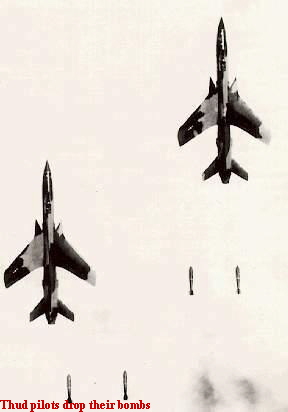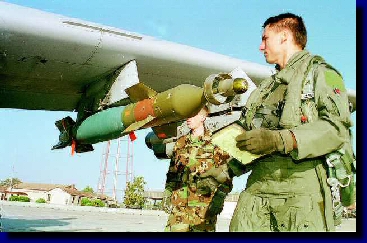|
Building the better bomb:
The development of Laser Guided
Munitions
By Shelby G. Spires
Locked away in an archive, a 1965 aerial
photograph tells the story of a thousand misses, a thousand sorties and a
thousand personal stories of horror in the quest to drop the Ham Rung, or
Dragon's Jaw, Bridge in Than Hoa, North Vietnam. At the height of the Vietnam
War, the bridge stood defiantly against the technological might of a nation
which could orbit spaceships around the earth, but could not manage to bullseye
a bomb on a French built bridge 10,000 miles away in Southeast Asia.
The
stark black and white photo shows a bridge, a river and thousands of water
filled craters in the ground -- missed bombs -- made in the attempt to drop the
bridge. The effort had been costly in terms of aircrews and aircraft lost, and
yet the Dragon's Jaw, as bridge was nicknamed, still remained open to traffic.
The bridge was one of hundreds of targets over Southeast Asia which were either
too well defended to bomb accurately or protected by Washington due to fears
over civilian deaths that may result from a stray bomb.
The problems
weren't due to any lack of effort on the part of American aircrews in 1965. That
the North Vietnamese prison were quickly filling up with pilots, navigators and
weapons system operators, attest to their courage. Difficulties with bombing
were quickly identified from Thailand to Washington, aircrews flying sorties
over Southeast Asia didn't have the proper tools for the job.
F-105
"Thunderchief" pilot Nick Lacey knew there was a problem. He flew a
fighter-bomber designed for nuclear strike against targets in Europe, but used
it as the backbone of the American strategy to attack targets in the jungles and
plains of Southeast Asia. Loaded up with fat World War II iron bombs, Lacey
flew the F-105 on strikes against well protected, entrenched targets during
Operation Rolling Thunder -- the three year bombing campaign designed to force
the North Vietnamese to the peace table.
"For what it was designed for
'The Thud' was a great aircraft. Get low, fly in below the enemies defenses and
loft a bomb -- an atomic bomb more than likely -- and leave the area. But for
dive bombing small targets like trucks and even bridges in Vietnam ... it was
difficult. It just wasn't designed for that," the retired Air Force colonel
said . .
The accuracy problems cost the American military
in the terms of dead and imprisoned aircrews and lost aircraft, but it also
created the vicious circle of overkill. Because leaders in Washington couldn't
be certain a target had been destroyed, they required multiple sorties back to
the same place to expend ordnance on phantom structures. "I remember going back
to targets in North Vietnam a few times to drop bombs on something that wasn't
there. Light, shadows and angle of sight had created an illusion on photo
reconnaissance that there was something left, and there was nothing there. We
were just going up north for no reason," Lacey said. "We had to face the
(Surface-to-Air-Missiles) and ground fire all over again for a target that
probably had been obliterated days before."
The military needed a weapon
to keep airmen out of range of ground fire and one accurate enough to cut out
needless trips back to a target which was already destroyed. The need was a
precision guided munition which was safe, cheap and easy to use.
Leaders
in the Pentagon had a problem of their own, one of denial. It would take a
Texas Instruments engineer, a laser light scientist in Alabama, a head strong
Air Force colonel in Florida and a lot of crazy ideas to convince Washington
that American aircrews couldn't hit a bullseye with their bombs and a solution
was needed.
"The Air Force didn't have a bombing problem. Or that's what
they would tell you. It was all bureaucratic stuff. The guys over there
dropping the bombs knew there was a bombing problem, and people here in the
states knew there was a bombing problem. But trying to fix it meant admitting
there was a problem. It was crazy," the man who headed the development team of
the first effective laser guided munition Weldon Word said. "I remember one
colonel I was with saying 'The Air Force doesn't have a bombing problem. Let me
tell you what we did 15 years ago, in Korea. There all you had to do was tell
me which railroad ties you wanted our bombs to be placed on and we would go up
and do it. That was in Korea. Think how much better we are now.' They had
lost I don't know how many airplanes trying to drop the Than Hoa bridge. The
Air Force had a bombing problem, but for whatever reasons they wouldn't admit
it."
Continue to "The Early Work"
|
|














